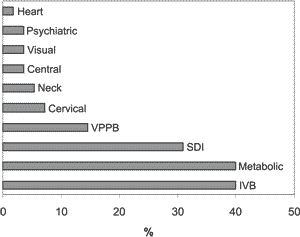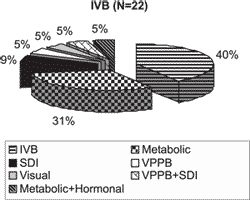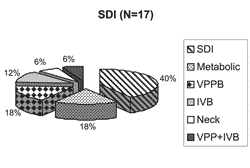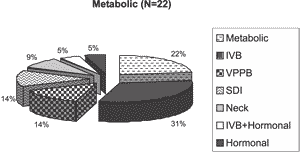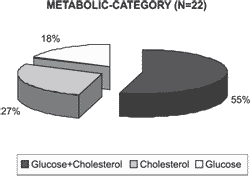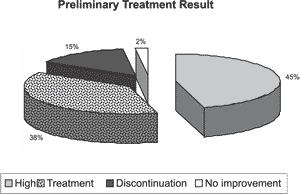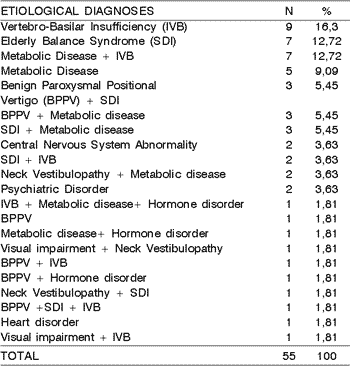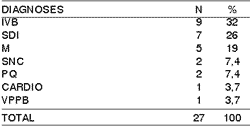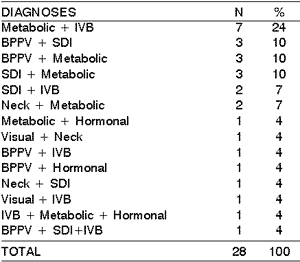

Year: 2003 Vol. 69 Ed. 6 - (7º)
Artigo Original
Pages: 772 to 777
Diagnostic approach of balance in the elderly: preliminary results
Author(s):
Lucinda Simoceli1 Roseli
Moreira Saraiva Bittar2,
Marco Aurélio Bottino2,
Ricardo Ferreira Bento3
Keywords: vertigo, imbalance, elderly, vestibular rehabilitation
Abstract:
Study Design: This study aimed to determine the prevalence of the different aspects of older patients presenting with dizziness. Material and Methods: Fifty-five patients who complained of disequilibrium and/or dizziness from the Ambulatório de Otoneurologia Geriátrica do Hospital das Clínicas do HCFMUSP, between august/2001 and mars/2003 were analyzed. The authors characterized these population about sex, age, etiological factors of the complaints about equilibrium, adopted treatments and its results. Results: Disequilibrium in older people has multiple different causes in 51% of the subjects, and the more frequent etiologies are: Vertebro Basilar Insufficiency - VBI (40%), Cholesterol and Sugar alterations (40%), Age-related Deterioration of Vestibular System (30%), Benign paroxysmal postural vertigo BPPV (14,5%), Cervical Syndrome (7,2%) and Hormonal alterations (5,4%). Conclusion: Disequilibrium in older people is commonly due to two or more etiologies. These findings suggest that a multidisciplinary evaluation is fundamental when the objective is to treat the older patient with dizziness or balance problems.
![]()
Introduction
The affections of body balance, clinically characterized as dizziness, vertigo, lack of equilibrium and falls are among the most common complaints of the elderly population and comprise a highly relevant medical problem.
It is estimated that the prevalence of balance complaints in the population over the age of 65 years reaches 85% 1, 2, normally associated with many etiologies, which can be manifested by loss of balance, gait deviations, instability, nausea and frequent falls3-5. These affections of posture control are associated in the elderly with higher risk of falls and the consequent sequels, which have high morbidity.
Currently, fractures resulting from falls are responsible for approximately 70% of accidental deaths in people over 75 years of age 6. Comparing to children, who also have a high rate of falls, the elderly experience 10 times more hospitalizations and eight times more death as a result of falls, a rate that increases directly as a result of survival years.
Considering only the problem of imbalance, the geriatric population presents a continuous increase in sensorial function disorders, integration of central peripheral information, as well as senescence of neuromuscular systems and skeletal functions 7. Elderly people are more prone to diseases that directly modify these functions, such as for example diabetes, atherosclerosis, central vascular accident and depression, which lead to limitation of motor activities resulting from loss of muscle mass, flexibility and skeletal integrity.
Precise identification of the cause of imbalance should involve clinical assessment directed to the patients' complaints, associated diseases, as well as complete assessment of the systems involved in body balance and its occasional limitations.
The purpose of the present study was to characterize the prevalence of etiologies that result in body balance disorders in elderly patients seen by the Division of Otoneurology of HCFMUSP.
Material and Method
Our sample represents a transversal section of the Ambulatory of Geriatric Otoneurology, Department of Otorhinolaryngology, HCFMUSP, between August 2001 and March 2003, comprising 55 patients. The data described present the results of a prospective study about the characteristics of the elderly population (aged over 65) with complaints of body balance disorders, defined as loss of balance and/or dizziness.
All patients were submitted to standardized clinical assessment using a form for otoneurological assessment, comprising anamnesis directed to complaints of balance, correlated symptoms and associated diseases, general and otoneurological examination, audiometric assessment, laboratory exams for metabolic and hematological disorders, electronystagmographic examination, if indicated, to elucidate the diagnostic investigation, computed posture analysis to quantify balance deficits, and other specific exams, depending on the etiology involved.
The patients were characterized concerning their age distribution, gender, etiology related to balance disorder, adopted management and the partial results of proposed treatment.
Graph 1. Distribution of presented diagnoses by frequency.
Graph 2. IVB and associated etiologies.
Graph 3. SDI and associated etiologies.
Graph 4. Metabolic disorders and associated etiologies.
Graph 5. Distribution of metabolic affections.
Graph 6. Distribution of patients according to response to adopted treatment.
Results
Out of 55 assessed patients, 45 were female (81.8%) and 10 were male subjects (18.2%). The mean age of patients was 72.3 years (standard deviation ± 6.46 years) and median of 71 years.
Upon analyzing the etiologies found, we observed 27 patients (49%) with one single etiology related to the picture of imbalance, whereas 28 patients (51%) presented 2 or more etiologies (2 patients with 3 etiologies). On average we confirmed 1.52 diagnoses for each studied patient.
Considering all the etiologies detected, we can see in Table 1 the wide range of underlying deficits that had triggered the balance disorders in these patients.
Among the main groups of pathologies, considering the data from the sample, we could observe that an elderly patient with complaint of imbalance and/or dizziness presents distribution of etiological factors for body imbalance according to Graph 1.
In patients that presented only one etiology for balance disorders, we observed distribution of diagnoses as shown in Table 2.
The association and frequency of diagnosed pathologies can be observed in Table 3.
Considering the predominant etiologies in the studied population, we observed the combinations shown in Graphs 2 and 3.
The group that presented metabolic disorders was distributed as shown in Graphs 4 and 5.
Out of 8 patients with benign paroxysmal positional vertigo (BPPV), 7 presented clinical signs of posterior semicircular canal deficit, with positive Dix Hallpike, and one patient with lateral semicircular canal affection presented horizontal nystagmus in the investigation for positional vertigo.
Four patients were diagnosed with neck vestibulopathy.
The 3 patients with hormone alterations presented diagnosis of hypothyroidism.
Advocated Treatment
All patients that presented metabolic and hormonal disorders were followed up and clinically treated. The patients with benign paroxysmal positional vertigo were submitted to canal repositioning maneuvers depending on the affected canal and those that presented neck disorders were referred to physical therapy (Graph 6).
Considering that 28 patients (50.9%) presented more than one etiology for imbalance, in addition to the above referred treatments, most of them were submitted to more than one therapeutic approach, among which the most frequent one was vestibular rehabilitation, indicated in 33 subjects (60%).Table 1. Distribution of etiological factors of imbalance in the studied population.
Table 2. Distribution of single etiologies.
Table 3. Distribution of associated etiologies.
Discussion
In previous studies about balance disorders in the elderly, the prevalence of specific etiologies ranged enormously, and in most cases, multiple causes were identified. Some authors proposed that balance in the elderly would be understood as a Geriatric syndrome, characterized by multi-sensorial affections and diseases in many systems and organs such as fall, delirium and urinary incontinence 8, 9.
Dizziness is a prevalent symptom in these patients, estimated between 13% and 38%, depending on the studied situation. The presence is associated with increase in number of falls and syncope, neuromotor functional sequels, increase in length of hospital stay, cerebral vascular accidents and death 10, 11, 12, 13, 14. Considering the frequency of dizziness and its associated morbidity, much attention should be given to defining the causes of body imbalance.
The diagnostic findings in these patients vary considerably. The peripheral vestibular diseases are identified as the primary cause or contributing factor between 4 and 64% of the patients 15, 16, 17. Similarly, vascular alterations are identified in up to 70% of the cases, psychiatric diseases in up to 40%, cervical diseases, especially spondilloarthrosis, in 0% to 66% 16, 18, 19. The frequency of cases in which the etiology is not identified ranges from 8 to 22%, whereas multiple diagnoses are made in up t 85% of the cases.
This discrepancy of data is probably partly due to different studied population, different diagnostic criteria used, as well as the professionals involved in the study (geriatric physicians, otorhinolaryngologists, general practitioners) and their therapeutic approaches.
Most of the authors, however, agree that when talking about balance disorders in the elderly, the term multifactorial should always be present, since there are innumerous factors of concurrent risk, such as presence of cardiovascular, neurological and muscle-skeletal diseases, diabetes, idiopathic syncope, use of different classes of drugs, including diuretics, anticonvulsant drugs, antihypertensive, anxiolytic and antidepressants 10, 11, 20.
In our study, 51% of the patients presented more than one etiology responsible for the balance disorder. We had on average 1.52 diagnoses per patient, data that agree with the previous reports made by Katsarkas17, with 1.14 diagnoses in the assessment of an elderly group of 1,194 patients.
The patients that did not present defined etiology for any specific deficit were diagnosed as having Elderly Imbalance Disorder (SDI) or Presbiastasia, as previously described by other authors 21, 22. These cases with no definite diagnosis are considered as having SDI, in our opinion, due to the fact that posture and stability deficits result from the interaction of various sensorial-motor systems under neurological control, and dizziness may be the resulting factor of the disorder in only single system, or as in most cases, lesions of different intensity in almost of them.
As to specific etiologies, reviewing the literature we observed that some authors mentioned the prevalence of Meniere's disease in the elderly population in about 8% of the cases17, 23, 24, 25. We did not observe any classical case of Meniere's disease, but we did detect some patients with metabolic affections that sometimes described balance deficit with marked vertigo associated with tinnitus, but without hearing fluctuation. Considering that these patients presented specific lipid or glucose metabolism affections, the corrections led to resolution of the affections and we did not diagnose them as having idiopathic Meniere's disease episodes, even though hydrops had probably been the anatomical-physiological substrate of the complaint.
As to BPPV, we observed prevalence of 14.5%, which contrast with the previous data, reported as 20 and 34% of BPPV in the elderly 15, 17, 23, 36. We believe that the low incidence of this pathology in our population was due to the fact that our ambulatory is a reference center; all patients whose clinical control of balance disorders is not properly managed by a general physician are transferred here. Since BPPV is easy to diagnose and treat, we were referred only patients whose diagnosis was doubtful or who presented other concomitant pathologies, as an added factor to confuse the approach of balance. Similarly, we had no diagnosis of vestibular neuronitis either, since our patients in general present chronic episodes of dizziness 23.
Proprioceptive deficits are reported as being responsible for approximately 17% of the cases of imbalance in the elderly, being that in 7% of the cases, they can be the primary cause of the disease 15. We believe that based on the study of dynamic computed posture analysis we can expand the number of cases diagnosed as having isolated proprioceptive dysfunction versus associated with other etiologies, making our sample closer to that of other authors. We observed 3.6% of psychiatric alterations as the main determinant for balance disorders, confirming the data of 3 to 10% reported in the literature 15, 23.
Most of the authors classified separately cardiovascular and central disorders. In our study, we considered the former as mixed balance disorders, since affections to blood flow determine the onset of vestibular pathologies of peripheral and central origin, and therefore, we observed a prevalence of 40% of vascular alterations in this population characterized as IVB by the presence of abnormal vertebral artery doppler and/or positive response to vertebral-basilar deprivation nystagmus. Other authors preferred to define it only as cardiovascular alterations and for this reason, the prevalence was about 21 to 34% 9, 16, 23, 27.
In our diagnostic criteria, both IVB and SDI presented characteristics of mixed disorders with vascular, central and peripheral deficits, showing manifestations in about 75% of the patients.
Metabolic affections were present in 40% of the population, agreeing with previous references of about 59% of the patients, being the primary etiology in 22% 15. We did not consider any etiology as primary since in the elderly population, all factors are impaired and they seem to be equally important in the manifestations of imbalance.
Our study suggested that a professional that works with balance disorders should bear in mind not to search for a specific diagnosis, but rather to consider all possible clinical variables that can be affected. In these patients, it is important to assess the underlying diseases, such as cardiovascular, metabolic, hormonal disorders, depression and anxiety, sensorial status and posture alterations, as well as to review the medication used 28, 29 and life habits, so that the potential factors that have led them to imbalance can be identified.
CONCLUSION
The association of alterations in multiple organs and systems (cardiovascular, metabolic, neurological, sensorial, psychological, hormonal) as triggering factor of dizziness is the key to appropriate approach of imbalance in the elderly. We realized the need to use a multidisciplinary approach (otorhinolaryngologists, geriatric specialists, cardiologists, speech therapists, physical therapists) to obtain complete rehabilitation of imbalance in these patients, minimizing the associated risks and morbidity of falls and social isolation of subjects.
REFERENCES
1. Bittar RSM, Pedalini MEB, Sznifer J, Formigoni LG. Reabilitação Vestibular: Opção Terapêutica na Síndrome do desequilíbrio do idoso. Gerontologia 2000; 8(1): 9-12.
2. Hirvonen TP, Aalto H, Pyykko I, Juhola M, Jantti P. Changes in vestibulo-ocular reflex of elderly people. Acta Otolaryingol Suppl (Stockh) 1997; 529: 108-10.
3. Schuknecht HF. Pathology of the Ear. Cambridge, Massachusetts: Harvard University Press; 1974.
4. Norré ME, De Weerdt W. Vestibular habituation training. Technique and first results. Acta-Oto-Rhyno-Laryngol Belg 1979; 33 (3): 347-69.
5. Weinchuch R, Korper SP, Hadley E. The prevalence of desequilibrium and related disorders in older persons. Acta Otolaryngol Suppl (Stockh) 1997; 529:108-10.
6. Fuller GF. Falls in the elderly. Am Fam Physician 2000; 61:2159-74.
7. Konrad HR, Girardi M, Helfert R. Balance and Aging. Laryngoscope 1999; 109: 454-60.
8. Tinetti ME, Inouye SK, Gill TM, Doucette JT. Shared risk factors for falls, incontinence, and functional dependence. Unifying the approach to geriatric syndromes. JAMA 1995; 273:1348-53.
9. Tinetti ME, Williams CS, Gill TM. Dizziness among older adults: A possible geriatric syndrome. Annals of Internal Medicine 2000; 132 (5): 337-44.
10. Tilvis RJ, Hakula SM, Valvanne J, Erkinjuntti T. Postural hypotension and dizziness in a general aged population: a four-year follow-up of the Helsinki Aging Study. J Am Geriatr Soc 1996; 44:809-14.
11. Ensrud KE, Nevitt MC, Yunis C, Hulley SB, Grimm RH, Cummings SR. Postural hypotension and postural dizziness in elderly women. Arch Intern Med 1992; 152:1058-64.
12. Sloane P, Blazer D, George LK. Dizziness in a community elderly population. J Am Geriatr Soc 1989; 37:101-8.
13. Sixt E, Landahl S. Postural disturbances in a 75-year old population: Prevalence and functional consequences. Age Ageing 1987; 16:393-8.
14. Grimby A, Rosenhall U. Health-related quality of life and dizziness in old age. Gerontology 1995; 41:286-98.
15. Davis LE. Dizziness in elderly men. J Am Geriatr Soc 1994; 42(11): 1184-8.
16. Lawson J, Fitzgerald J, Birchall J, Aldren CP, Kenny RA. Diagnosis of geriatric patients with severe dizziness. J Am Geriatr Soc 1999; 47:12-7.
17. Katsarkas A. Dizziness in aging: a retrospective study of 1194 cases. Otolaryngol Head Neck Surg 1994; 110:296-301.
18. Colledge NR, Barr-Hamilton RM, Lewis SJ, Sellar RJ, Wilson JA. Evaluation of investigations to diagnose the cause of dizziness in elderly people: a community based controlled study. BMJ 1996; 313:788-92.
19. Sloane PD, Hartman M, Mitchell CM. Psychological factors associated with chronic dizziness in patients aged 60 and older. J Am Geriatr Soc 1994; 42:847-52.
20. Colledge NR, Wilson JA, MacIntyre CC, MacLennan WJ. The prevalence and characteristics of dizziness in an elderly community. Age Ageing 1994; 23:117-20.
21. Bittar RSM, Pedalini MEB, Bottino MA, Formigoni LG. Síndrome do desequilíbrio do idoso. Pró Fono Revista de Atualização Científica, Brasil 2002; 14(1):119-28.
22. Belal JR, gloric A. Desequilibrium of aging. J. Laryngol Otol 1986; 100:1037-41.
23. Baloh RW, Sloane PD, Honrubia V. Quantitative vestibular function testing in elderly patients with dizziness. ENT 1989; 68(12): 935-9.
24. Ballester M, Liard P, Vibert D, Hausler R. Ménière Disease in the elderly. Otology & Neurotology 2002; 23:73-8.
25. Ishiyama G, Ishiyama A, Jacoson K, Baloh RW. Drop attacks in older patients secondary to an otologic cause. Brief Communications. Neurology 2001; 57(6).
26. Norré ME, Beckers A. Benign Paroxysmal Positional Vertigo in the elderly. Treatment by habituation exercises. JAGS 1988; 36:425-9.
27. Hall WJ, Leipzig RM. Update in Geriatrics. Annals of Internal Medicine 2000; 133(11): 894-900.
28. Tinetti ME, Baker DI, McAvay G, Claus EB, Garrett P, Gottschalk M, et al. A multifactorial intervention to reduce the risk of falling among elderly people living in the community. N Engl J Med 1994; 331:821-7.
29. Inouye SK, Bogardus ST, Charpentier PA, Leo-Summers L, Acampora D, Holford TR, et al. A multicomponent intervention to prevent delirium in hospitalized older patients. N Engl J Med 1999; 340:669-76.
1 Post-graduation studies under course, Discipline of Otorhinolaryngology, FMUSP.
2 Ph.D., Assistant of the Division of Otoneurology, HCFMUSP.
3 Associated Professor, Medical School, University of São Paulo (FMUSP).
Discipline of Otorhinolaryngology, Hospital das Clínicas, FMUSP.
Address correspondence to: Lucinda Simoceli - Depto de ORL do HCFMUSP -
R. Dr. Enéas de Carvalho Aguiar,.255 6o andar sala 6021 São Paulo SP Brasil 05403-000.
E-mail: otoneuro@hcnet.usp.br
Article submitted on August 15, 2003. Article accepted on September 25, 2003.
